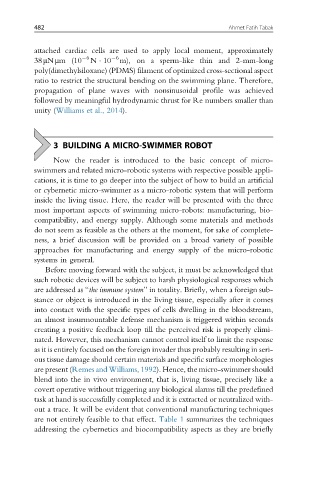Page 488 - Handbook of Biomechatronics
P. 488
482 Ahmet Fatih Tabak
attached cardiac cells are used to apply local moment, approximately
6 6
38μNμm (10 N 10 m), on a sperm-like thin and 2-mm-long
poly(dimethylsiloxane) (PDMS) filament of optimized cross-sectional aspect
ratio to restrict the structural bending on the swimming plane. Therefore,
propagation of plane waves with nonsinusoidal profile was achieved
followed by meaningful hydrodynamic thrust for Re numbers smaller than
unity (Williams et al., 2014).
3 BUILDING A MICRO-SWIMMER ROBOT
Now the reader is introduced to the basic concept of micro-
swimmers and related micro-robotic systems with respective possible appli-
cations, it is time to go deeper into the subject of how to build an artificial
or cybernetic micro-swimmer as a micro-robotic system that will perform
inside the living tissue. Here, the reader will be presented with the three
most important aspects of swimming micro-robots: manufacturing, bio-
compatibility, and energy supply. Although some materials and methods
do not seem as feasible as the others at the moment, for sake of complete-
ness, a brief discussion will be provided on a broad variety of possible
approaches for manufacturing and energy supply of the micro-robotic
systems in general.
Before moving forward with the subject, it must be acknowledged that
such robotic devices will be subject to harsh physiological responses which
are addressed as “the immune system” in totality. Briefly, when a foreign sub-
stance or object is introduced in the living tissue, especially after it comes
into contact with the specific types of cells dwelling in the bloodstream,
an almost insurmountable defense mechanism is triggered within seconds
creating a positive feedback loop till the perceived risk is properly elimi-
nated. However, this mechanism cannot control itself to limit the response
as it is entirely focused on the foreign invader thus probably resulting in seri-
ous tissue damage should certain materials and specific surface morphologies
are present (Remes and Williams, 1992). Hence, the micro-swimmer should
blend into the in vivo environment, that is, living tissue, precisely like a
covert operative without triggering any biological alarms till the predefined
task at hand is successfully completed and it is extracted or neutralized with-
out a trace. It will be evident that conventional manufacturing techniques
are not entirely feasible to that effect. Table 1 summarizes the techniques
addressing the cybernetics and biocompatibility aspects as they are briefly

